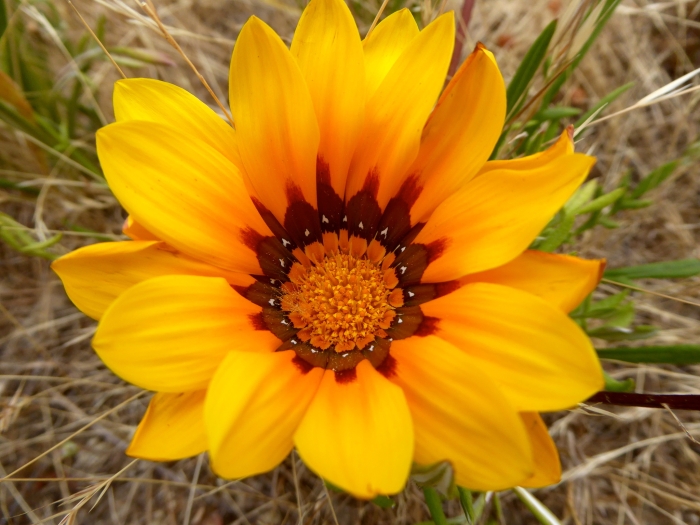Treasureflower
(Gazania linearis)
Treasureflower (Gazania linearis)
/
/

Rudyard
CC BY 4.0
Image By:
Rudyard
Recorded By:
Copyright:
CC BY 4.0
Copyright Notice:
Photo by: Rudyard | License Type: CC BY 4.0 | License URL: http://creativecommons.org/licenses/by/4.0/ | Rights Holder: Rudyard | Publisher: iNaturalist | Date Created: 2016-05-21T11:58:37-07:00 |



































Estimated Native Range
Summary
Gazania linearis, commonly known as Treasureflower, is an evergreen or semi-deciduous clumping perennial herb native to the plains and grasslands of South Africa. It is well-adapted to open, sunny environments and thrives in well-drained soils. The plant reaches a typical height of 10-30 cm (4-12 inches) and spreads to form dense mats. Treasureflower produces large, showy daisy-like flower heads in bright yellow and orange hues, with variations in cultivated varieties. The flowers, which can be up to 8 centimeters (3 inches) across, feature a dark reddish center of disc florets surrounded by approximately 20 long ray florets. These ray florets often have distinctive dark spots near their bases and may curl upwards at the edges. The flowers are known to close at night and on cloudy days.
Treasureflower is valued for its vibrant blooms and ability to withstand drought, making it a popular choice for rock gardens, coastal planting, and as ground cover in sunny, dry areas. It is also used for its low maintenance and long flowering season, which extends from spring to fall in temperate climates. While it prefers full sun, it can tolerate light shade and requires minimal water once established, thriving in sandy or well-drained soils. However, gardeners should be cautious as Gazania linearis can be potentially invasive outside its native range, particularly in regions like California. It is advisable to check local regulations before planting.
Potential problems include susceptibility to root rot in poorly drained soils and mildew in humid conditions. Cultivars with varied flower colors and patterns are available, enhancing its ornamental appeal.CC BY-SA 4.0
Treasureflower is valued for its vibrant blooms and ability to withstand drought, making it a popular choice for rock gardens, coastal planting, and as ground cover in sunny, dry areas. It is also used for its low maintenance and long flowering season, which extends from spring to fall in temperate climates. While it prefers full sun, it can tolerate light shade and requires minimal water once established, thriving in sandy or well-drained soils. However, gardeners should be cautious as Gazania linearis can be potentially invasive outside its native range, particularly in regions like California. It is advisable to check local regulations before planting.
Potential problems include susceptibility to root rot in poorly drained soils and mildew in humid conditions. Cultivars with varied flower colors and patterns are available, enhancing its ornamental appeal.CC BY-SA 4.0
Plant Description
- Plant Type: Herb
- Height: 0.3-0.5 feet
- Width: 0.5-1 feet
- Growth Rate: Moderate
- Flower Color: Yellow
- Flowering Season: Spring, Fall
- Leaf Retention: Evergreen
Growth Requirements
- Sun: Full Sun
- Water: Medium
- Drainage: Fast
Common Uses
Bank Stabilization, Bee Garden, Bird Garden, Border Plant, Butterfly Garden, Drought Tolerant, Groundcover, Low Maintenance, Potted Plant, Rock Garden, Showy Flowers
Natural Habitat
Native to the plains and grasslands of South Africa
Other Names
Common Names: Striped Treasure Flower, 가는잎태양국
Scientific Names: , Gazania linearis, Gazania longiscapa, Gazaniopsis stenophylla, Gazania subulata, Mussinia linearis, Gazania kraussii, Gazania multijuga, Gorteria linearis, Arctotis staticefolia
GBIF Accepted Name: Gazania linearis (Thunb.) Druce